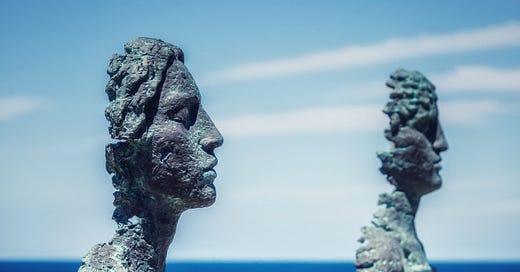Creating the Webbd Wheel: Swallowing Monsters
In which we open wide ...
Life is an unexpected journey. We wind up in places we never knew existed, let alone that we would one day travel there. This can be a delight, a constant source of curiosity and wonder.
It can also be journeys into hellscapes we couldn’t possibly imagine.
One of the things we do as humans is create. From earliest times artists, storytellers, dancers, and singers have lived among us, inspired by the events and living beings around us. They have recorded their experience for themselves, their communities, and posterity. Because of them, we have a glimpse of how people lived tens of thousands of years ago.
When terrible things happen to us, fighting our way back to a desire to live and thrive can seem impossible. We often cover these wounds and get on with life, but our joy is quenched, and our wounds go on bleeding until we find a way to heal them.
Many find healing through creativity. To dance in our blood, to paint with our tears, to sculpt with our rage, to compose with our passion, is to expose our trauma to the sun and air, to stop hiding it, to cleanse it, and often to discover we are not alone. Others can recognize our hurt, be moved by it, respond to it. The act of creative sharing begins our healing and adds to our cultural wisdom. Those who come after us and suffer as we did are not as alone as we felt, because we walked the same road and survived it. We left cairns and notched trees, we scratched signs and arrows on rocks, we left a stub of a candle to light the way for those who must walk in the dark in their turn.
The act of story-making is an integration of experience, an act of connection from human to humanity. When we mythologize or tell stories, we are creating a map, a record, a dressing for infected wounds. Sometimes this process takes a long time. No one recovers from deep trauma easily or quickly. We all carry stories we live and re-live.
Running away, hiding, denial, and distraction don’t heal trauma. Sooner or later, if we are to find healing and move on, we must face our monsters. We must swallow our demons. We must look them in the eye, smell them, feel them, hold them tightly to us, allow them to mutter in our ears.
It’s an act of courage to transform the foulness of our wounds into healing flesh. It’s an act of courage to reveal our wounds to the eyes of the world. It’s an act of grace to make something unique from such material.
In post #30, Kunik tells a story, a hard story about a lost child who is outcast. A personal story. It’s the first time he’s told the story, this young man. He waits for the right audience, the right time, the right place. The story is not a mirror. He doesn’t put himself in the center of it in any obvious way. He understands himself in the context of a wider a world. He makes a story about what it is to be lost, to be outcast, exiled, helpless. He makes a story about mysterious events, about the enigmatic and beautiful natural world.
He tells a story any human being can understand, be touched by, and perhaps relate to.
I can’t speak for other writers, but my writing almost invariably comes from playtime with my monsters. We speak to each other. We remember together. They teach me about lies, distortions, self-care and self-loathing. They teach me about patterns and choices. They have expectations, even after all these years, that I will flee, hide, engage in self-destruction, lock myself into depression, give up, give in, and, above all, never reveal to anyone how loathsome and broken I am.
The act of creation is my rebellion. Eventually, everything in my experience winds up in my writing. Everything. Especially the worst things, the things I most fear and feel the most shame about. But the writing is not me-centric. Obviously, I work with many different characters. They’re all me, and none of them are me. What I have experienced is not unique. These books are not about me specifically. They’re about being human, being in community, being in conflict, being in breakdown. I’ve experienced all those. So have you.
I don’t believe we can run away. There’s nowhere to hide. We carry our monsters with us wherever we go. It’s horrifying, it’s counterintuitive, and it feels like the end of everything to simply open ourselves as widely as we can and swallow those demons. To take back our power. To integrate and re-assimilate and use them rather than being used by them.
One way to do that is to make a story and give it to the world.
(This essay was published with post #30 of The Hanged Man.)



